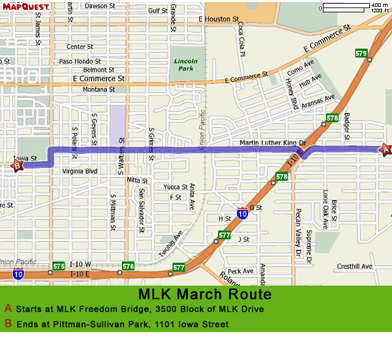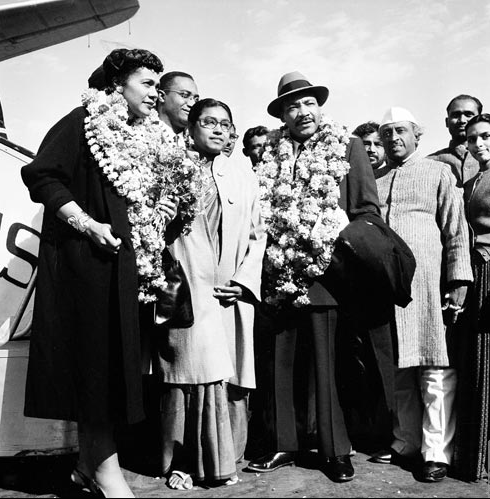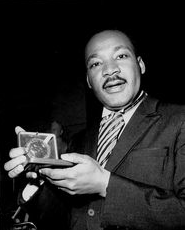|
Topic Sentence: Like Gandhi, King used civil disobedience as a means of effectuating government change. It took the form of large-scale, non-violent refusals to obey government commands.
Civil Disobedience is the refusal to obey government demands or commands and nonresistance to consequent arrest and punishment. The act of civil disobedience is often a symbolic violation of the law, which is used especially as a nonviolent and collective means of forcing government concessions. Most people who have committed civil disobedience in their society do so with the acceptance of consequences such as arrest, physical beatings, and even death. “An individual who breaks a law that conscience tells him is unjust, and who willingly accepts the penalty of imprisonment in order to arouse the conscience of the community over its injustice, is in reality expressing the highest respect for the law”-Martin Luther King Jr. Dr. Martin Luther King Jr., one of the most respected and remembered leaders during the Civil Rights movement, was born into a pastor’s family of the Ebenezer Baptist church in Atlanta Georgia in 1929. King attended segregated public schools in Georgia and graduated from high school at 15. After being elected president of a predominantly white senior class and receiving a B.A. degree from Morehouse College, King married Coretta Scott and later had two sons and two daughters. In 1954 King became pastor of Dexter Avenue Baptist Church in Montgomery, Alabama. King had always been a strong supporter of the civil rights however; terrible incidents and mistreatment of black people in America during the 1950’s stimulated his desire to become a leader of the Civil Rights movement. As a Baptist minister, Martin Luther King derived much of his philosophy of nonviolent civil disobedience from the Bible and from his understanding of the teachings of Jesus. However, King was also greatly influenced by certain non-Christian ideas. One of the most important of these was the philosophy of nonviolence practiced by Mohandas "Mahatma" Gandhi, the spiritual leader of India's independence movement in the first half of the 20th century. Gandhi’s ideas and philosophies showed King that it would be possible to fight for civil rights not with guns, bombs, lies, and propaganda, but with love and truth. King’s first opportunity to display Civil Disobedience in his society was in becoming a leader of The Montgomery Bus Boycott, which officially started on December 1, 1955. This day marked the beginning of a time where all the blacks of Montgomery, Alabama would boycott the city buses until they could sit anywhere they wanted, instead of being relegated to the back when a white boarded. In 1957 he was elected president of the Southern Christian Leadership Conference, an organization formed to provide new leadership for the civil rights movement. The ideals for this organization he took from Christianity; its operational techniques from Gandhi. During this time King spoke in many places about civil disobedience and injustice. On February 3, 1959, Dr. Martin Luther King Jr. took a five-week tour of India to study Mohandas Gandhi’s philosophy of nonviolence in which he met with many government leaders, supporters of Gandhi, and many other groups of people. In meeting with these people, King shared his views on the various treatments of race and nonviolence. Many supporters of Gandhi acknowledged and praised him for his efforts in Montgomery as acts of nonviolence. In his return to America, King led a massive protest in Birmingham, Alabama, that caught the attention of the entire world, providing what he called a coalition of conscience. The Freedom March took place in Washington, D.C., on August 28, 1963. Attended by over 250,000 protestors, this march is described as the largest demonstration ever seen in the nations capital, and one of the first to have extensive television coverage. 1963 was distinguished for racial unrest and civil rights demonstrations. Nationwide outrage and turmoil was sparked by media coverage of police actions in Birmingham, Alabama, where attack dogs and fire hoses were turned against protestors, many of whom were in their early teens or younger. Martin Luther King, Jr., was arrested and jailed during these protests, writing his famous "Letter From Birmingham City Jail," which advocates civil disobedience against unjust laws. After years of marches, protests, speeches, and conferences, April 4, 1968, Martin Luther King, Jr. was assassinated. He was standing on the balcony of the Lorraine Motel in Memphis, Tennessee, where he had come to lead a peaceful march in support of striking sanitation workers. Like Gandhi, King used civil disobedience as a means of effectuating government change. It took the form of large-scale, non-violent refusals to obey government commands. Although his protests and speeches caused great potential danger to him and his family and eventually led to his assassination, Martin Luther King Jr. had the courage and bravery to protest against discrimination and promote love and truth through the act of Civil Disobedience. -Katie Winston |
Video clip from the Freedom march
This is a map shows the route in which Martin Luther King Jr. led the Freedom march.
Martin Luther King Jr. and his wife, Coretta, both wearing garlands, are received by admirers in New Delhi, India, February 10, 1959.
At the age of thirty-five, Martin Luther King, Jr., was the youngest man to have received the Nobel Peace Prize
|
Bibliography
http://www.laits.utexas.edu/txp_media/html/ig/features/0607_01/slide3.html
http://www.nobelprize.org/nobel_prizes/peace/laureates/1964/king-bio.html
http://theindependent.ca/2014/01/20/dr-martin-luther-king-strategies-and-tactics-of-civil-disobedience/
http://www.infoplease.com/spot/marchonwashington.html
http://www.laits.utexas.edu/txp_media/html/ig/features/0607_01/slide3.html
http://www.nobelprize.org/nobel_prizes/peace/laureates/1964/king-bio.html
http://theindependent.ca/2014/01/20/dr-martin-luther-king-strategies-and-tactics-of-civil-disobedience/
http://www.infoplease.com/spot/marchonwashington.html



